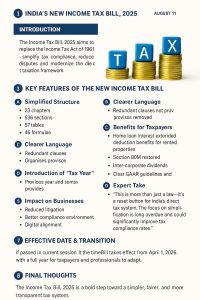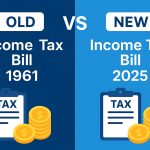Introduction
On August 11, 2025, India’s Parliament witnessed the tabling of a landmark piece of legislation — the Income Tax Bill, 2025. Designed to replace the Income Tax Act of 1961, this new law aims to simplify tax compliance, reduce disputes, and modernize the country’s direct taxation framework.

After months of committee reviews, public feedback, and significant revisions, the Bill is now positioned to shape India’s tax regime for decades to come.
1. Background – Why the Change Was Needed
The Income Tax Act, 1961, has served India for over six decades. But in that time, the country’s economy has transformed — from an industrial economy to a technology-driven, digital marketplace. The old law had grown bulky, with over 5 lakh words, 800+ sections, and numerous amendments, leading to confusion and legal disputes.
The new Bill aims to:
- Simplify language and structure
- Make compliance easier for individuals and businesses
- Align with the digital economy
- Reduce litigation
2. The Legislative Journey
| Date | Event |
|---|---|
| Feb 13, 2025 | Original Income Tax Bill introduced in Lok Sabha |
| Mar–Jul 2025 | Reviewed by Select Committee (4,500+ pages report, 285 recommendations) |
| Aug 8, 2025 | Government withdraws original draft to consolidate changes |
| Aug 11, 2025 | Revised Bill tabled in Parliament |
The revised draft incorporates almost all committee recommendations and aims for a smoother rollout.
3. Key Features of the New Income Tax Bill
A. Simplified Structure
- 23 chapters (down from 47 in the 1961 Act)
- 536 sections (down from 819)
- 57 tables and 46 formulae for clarity
- Word count reduced from 5.12 lakh to 2.6 lakh
B. Clearer Language
- Redundant clauses and provisos removed
- More logical, user-friendly arrangement
- Consistent terminology
C. Introduction of “Tax Year”
- No more confusion between “Previous Year” and “Assessment Year”
- A single Tax Year aligns income earning and filing cycles
D. Benefits for Taxpayers
- Home Loan Interest: Extended deduction benefits even for rented properties
- Inter-Corporate Dividend Deduction: Section 80M restored
- TDS/TCS Simplification: Faster refunds, easier NIL-TDS certificate issuance
- Clear GAAR (General Anti-Avoidance Rules) guidelines to prevent misuse
4. Impact on Individuals
- Simpler Filing: Easier-to-understand forms and terminology
- More Deductions: Especially for property owners and certain investments
- Predictable Rules: Lower risk of sudden changes in interpretation
5. Impact on Businesses
- Reduced Litigation: Clearer provisions reduce legal disputes
- Better Compliance Environment: Structured tables and formulae aid tax planning
- Digital Alignment: Laws account for modern business models, including e-commerce and gig economy players
6. Effective Date & Transition
- If passed in the current session, the Bill will take effect from April 1, 2026.
- The government aims to give taxpayers and professionals a full year to adapt to the changes.
7. Expert Take
“This is more than just a law—it’s a reset button for India’s direct tax system. The focus on simplification is long overdue and could significantly improve tax compliance rates.” — Tax Policy Analyst
8. Final Thoughts
The Income Tax Bill, 2025 is a bold step toward a simpler, fairer, and more transparent tax system. By replacing the decades-old 1961 Act, the government hopes to reduce complexity, encourage compliance, and make India’s tax regime globally competitive.
If implemented effectively, this could mark the beginning of a new era in India’s taxation—where taxpayers spend less time decoding legal jargon and more time focusing on growth.
Quick Summary Table
| Feature | Old Law | New Bill |
|---|---|---|
| Chapters | 47 | 23 |
| Sections | 819 | 536 |
| Word Count | 5.12 lakh | 2.6 lakh |
| Tax Year Concept | Previous & Assessment Years | Unified Tax Year |
| Home Loan Interest | Limited | Extended to rented properties |
| Deduction on Dividends | Restricted | Section 80M restored |
SEO Tags: Income Tax Bill 2025, India Tax Reform, August 11 Parliament Bill, New , Taxpayer Benefits, Tax Year, Section 80M, Home Loan Deduction India



